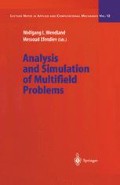Abstract
The isothermal and isobaric chemical vapour infiltration (CVI) process of pyrolytic carbon for producing carbon reinforced carbon fibres is investigated yielding a moving boundary problem to be solved. The growing surface of the substrate constitutes the free boundary due to steady deposition of solid pyrolytic carbon. A one-dimensional model for studying the infiltration of a single cylindrical pore is set up containing a simplified model of chemical kinetics as well as binary and Knudsen diffusion within the gas phase. This single pore model is integrated in a CVI reactor model additionally describing convection over a plane, porous substrate. Results of simulations reported here provide important insight in strategies to achieve a complete infiltration of a porous substrate.
Access this chapter
Tax calculation will be finalised at checkout
Purchases are for personal use only
Preview
Unable to display preview. Download preview PDF.
References
Middleman, S. (1989) The interaction of chemical kinetics and diffusion in the dynamics of chemical vapor infiltration, J. Mat. Res., 4, 1515–1524.
Hou, X., Li, H., Chen, Y., Li, K. (1999) Modeling of chemical vapor infiltration process for fabrication of carbon-carbon composites by finite difference methods, Carbon, 37, 669–677.
McAllister, P., Wolf. E. E. (1991) Modelling of chemical vapor infiltration of carbon in porous carbon substrates, Carbon, 29, 387–396.
Tago, Y. I. T., Kawase, M., Hashimoto, K. (2001) Numerical simulation of the thermal-gradient chemical vapor infiltration process for production of fiber-reinforced ceramic composite, Chem. Eng. Sci., 56, 2161–2170.
Langhoff, T.-A., Schnack, E. (2001) Modelling chemical vapour infiltration of pyrocarbon as moving boundary problem. Preprint 2001–4, Institute of Solid Mechanics, Karlsruhe University.
Author information
Authors and Affiliations
Editor information
Editors and Affiliations
Rights and permissions
Copyright information
© 2003 Springer-Verlag Berlin Heidelberg
About this paper
Cite this paper
Langhoff, TA., Schnack, E. (2003). Modelling chemical vapour infiltration of pyrolytic carbon. In: Wendland, W., Efendiev, M. (eds) Analysis and Simulation of Multifield Problems. Lecture Notes in Applied and Computational Mechanics, vol 12. Springer, Berlin, Heidelberg. https://doi.org/10.1007/978-3-540-36527-3_15
Download citation
DOI: https://doi.org/10.1007/978-3-540-36527-3_15
Publisher Name: Springer, Berlin, Heidelberg
Print ISBN: 978-3-642-05633-8
Online ISBN: 978-3-540-36527-3
eBook Packages: Springer Book Archive

